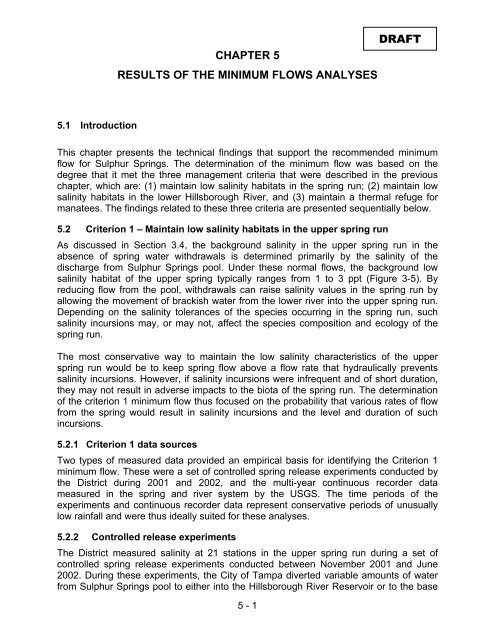The Determination of Minimum Flows for Sulphur Springs, Tampa
The Determination of Minimum Flows for Sulphur Springs, Tampa
The Determination of Minimum Flows for Sulphur Springs, Tampa
Create successful ePaper yourself
Turn your PDF publications into a flip-book with our unique Google optimized e-Paper software.
CHAPTER 5<br />
RESULTS OF THE MINIMUM FLOWS ANALYSES<br />
DRAFT<br />
5.1 Introduction<br />
This chapter presents the technical findings that support the recommended minimum<br />
flow <strong>for</strong> <strong>Sulphur</strong> <strong>Springs</strong>. <strong>The</strong> determination <strong>of</strong> the minimum flow was based on the<br />
degree that it met the three management criteria that were described in the previous<br />
chapter, which are: (1) maintain low salinity habitats in the spring run; (2) maintain low<br />
salinity habitats in the lower Hillsborough River, and (3) maintain a thermal refuge <strong>for</strong><br />
manatees. <strong>The</strong> findings related to these three criteria are presented sequentially below.<br />
5.2 Criterion 1 – Maintain low salinity habitats in the upper spring run<br />
As discussed in Section 3.4, the background salinity in the upper spring run in the<br />
absence <strong>of</strong> spring water withdrawals is determined primarily by the salinity <strong>of</strong> the<br />
discharge from <strong>Sulphur</strong> <strong>Springs</strong> pool. Under these normal flows, the background low<br />
salinity habitat <strong>of</strong> the upper spring typically ranges from 1 to 3 ppt (Figure 3-5). By<br />
reducing flow from the pool, withdrawals can raise salinity values in the spring run by<br />
allowing the movement <strong>of</strong> brackish water from the lower river into the upper spring run.<br />
Depending on the salinity tolerances <strong>of</strong> the species occurring in the spring run, such<br />
salinity incursions may, or may not, affect the species composition and ecology <strong>of</strong> the<br />
spring run.<br />
<strong>The</strong> most conservative way to maintain the low salinity characteristics <strong>of</strong> the upper<br />
spring run would be to keep spring flow above a flow rate that hydraulically prevents<br />
salinity incursions. However, if salinity incursions were infrequent and <strong>of</strong> short duration,<br />
they may not result in adverse impacts to the biota <strong>of</strong> the spring run. <strong>The</strong> determination<br />
<strong>of</strong> the criterion 1 minimum flow thus focused on the probability that various rates <strong>of</strong> flow<br />
from the spring would result in salinity incursions and the level and duration <strong>of</strong> such<br />
incursions.<br />
5.2.1 Criterion 1 data sources<br />
Two types <strong>of</strong> measured data provided an empirical basis <strong>for</strong> identifying the Criterion 1<br />
minimum flow. <strong>The</strong>se were a set <strong>of</strong> controlled spring release experiments conducted by<br />
the District during 2001 and 2002, and the multi-year continuous recorder data<br />
measured in the spring and river system by the USGS. <strong>The</strong> time periods <strong>of</strong> the<br />
experiments and continuous recorder data represent conservative periods <strong>of</strong> unusually<br />
low rainfall and were thus ideally suited <strong>for</strong> these analyses.<br />
5.2.2 Controlled release experiments<br />
<strong>The</strong> District measured salinity at 21 stations in the upper spring run during a set <strong>of</strong><br />
controlled spring release experiments conducted between November 2001 and June<br />
2002. During these experiments, the City <strong>of</strong> <strong>Tampa</strong> diverted variable amounts <strong>of</strong> water<br />
from <strong>Sulphur</strong> <strong>Springs</strong> pool to either into the Hillsborough River Reservoir or to the base<br />
5 - 1

















